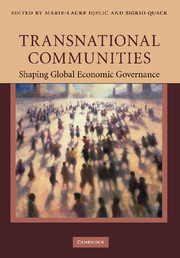Book contents
- Frontmatter
- Contents
- List of figures
- List of tables
- List of appendices
- Contributors
- Preface
- Part I Introduction
- Part II Classical communities with a transnational extension
- Part III Professional communities with a transnational extension
- Part IV Virtual communities
- Part V Transnational interest- or issue-based communities
- 11 The transnational temperance community
- 12 Industrial democracy in the European Community: trade unions as a defensive transnational community, 1968–1988
- 13 The making of a comprehensive transnational discourse community trade unions as a defensive transnational community, 1968–1988
- 14 Global warming, transnational communities, and economic entrepreneurship: the case of carbon capture and storage (CCS)
- 15 Communities of practice as cause and consequence of transnational governance: the evolution of social and environmental certification
- Part VI Conclusion
- Index
- References
11 - The transnational temperance community
Published online by Cambridge University Press: 07 September 2010
- Frontmatter
- Contents
- List of figures
- List of tables
- List of appendices
- Contributors
- Preface
- Part I Introduction
- Part II Classical communities with a transnational extension
- Part III Professional communities with a transnational extension
- Part IV Virtual communities
- Part V Transnational interest- or issue-based communities
- 11 The transnational temperance community
- 12 Industrial democracy in the European Community: trade unions as a defensive transnational community, 1968–1988
- 13 The making of a comprehensive transnational discourse community trade unions as a defensive transnational community, 1968–1988
- 14 Global warming, transnational communities, and economic entrepreneurship: the case of carbon capture and storage (CCS)
- 15 Communities of practice as cause and consequence of transnational governance: the evolution of social and environmental certification
- Part VI Conclusion
- Index
- References
Summary
The catholicity of the Temperance movement is remarkable. It links together in a fraternal bond of union, people of every nation, irrespective of colour, education, politics or religion, and through the agency of these bodies, the peoples of the earth are being linked together not only to drive the means of intoxication from the commerce of the world, but to secure peace and goodwill among nations.
Guy Hayler, International Prohibition Confederation (1914: 11)The world of international relations is no longer the sole dominion of state actors. From assessing the threat of transnational terrorism to the promise of transnational human rights and environmental advocacy networks, scholars have attempted to come to terms with the sudden and widespread expansion of transnational activism since the 1960s and 1970s (Kahler 2009). For one, Sidney Tarrow explains this development in terms of fundamental sociocultural changes, including “the growth of a stratum of individuals who travel regularly, read foreign books and journals, and become involved in networks of transnational activism abroad” (Tarrow 2005: 35). While the explosion in the quantity of such transnational communities – in which activists share particular values, identities, and policy goals – is of recent vintage, the transnational community itself is not. As far back as the nineteenth century, extensive webs of interaction and information exchange linked individuals, advocacy organizations, and policy-makers of different nationalities, simultaneously reflecting and sustaining shared values, beliefs, and projects (Keck and Sikkink 1998).
- Type
- Chapter
- Information
- Transnational CommunitiesShaping Global Economic Governance, pp. 255 - 281Publisher: Cambridge University PressPrint publication year: 2010



